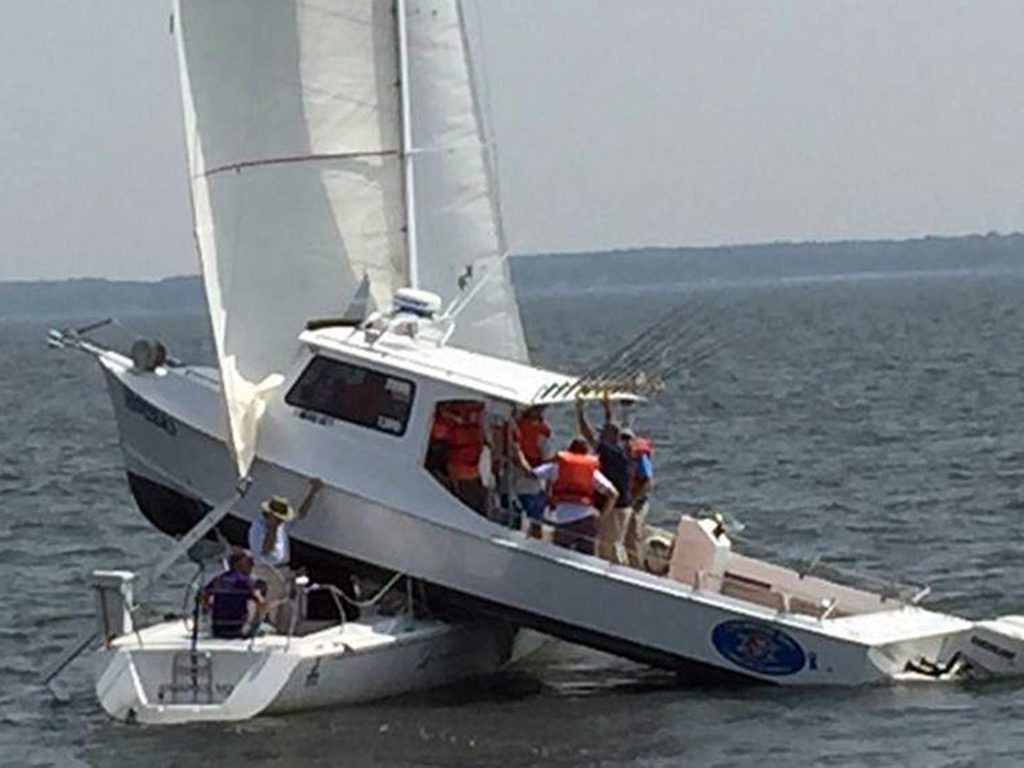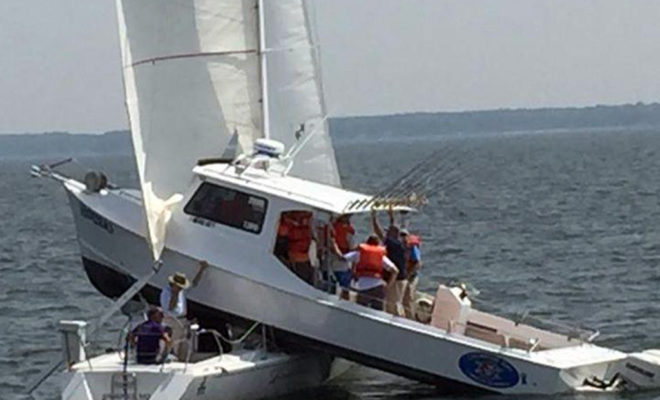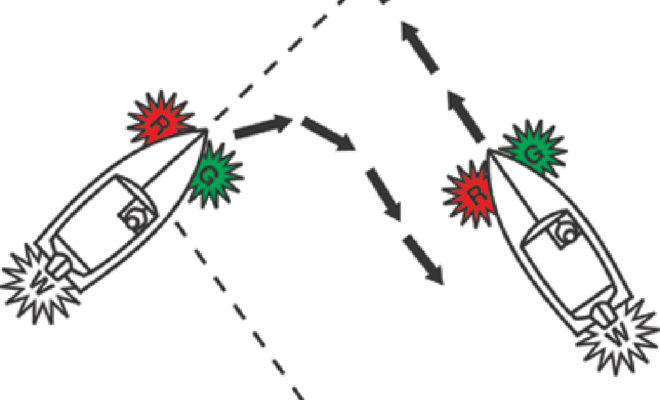Having spent a lot of time on the water this summer, it’s come to my attention that about 25% of boaters either don’t know or don’t respect the Boating Rules Of The Road.
I’m not talking about a couple of yahoos in a 20′ center console; I’m talking about 50′ Sportfisherman, Commercial Fishing Boats, and Island Ferries.
While a good knowledge of the Rules of the Road is important for all boaters, there are a couple of unique spots in and around Buzzards Bay that seem to have more trouble than others.
Understand that there are dozens of rules and I’m not going to hit them all in this report (you can find mucho detail on The BoatUS website).
The Crossing Rule
This is the Boating Rule of the Road that I see most often ignored and yet is the easiest to understand and follow.
Here’s the way BoatUS explains it:
Both International and Inland Rules state that when two power-driven vessels are crossing so as to involve risk of collision, the vessel which has the other on her starboard side (the give-way vessel) must keep out of the way. As the give-way vessel it is your duty to avoid a collision. Typically, this means you must alter speed or direction to cross behind the other vessel (the stand-on vessel).
In case you’re wondering, the term “give-way vessel” applies to the boat that must turn right to avoid a collision. The “stand-on vessel” is the boat that has the right of way.
Yes, I know there are a number of mitigating factors that come into play when the two boats aren’t both power boats or vary significantly in size, but for 99% of the power boats in Buzzards Bay, this is the most basic rule of the road.
In terms of Buzzards Bay, I see boaters ignore this rule most often entering and existing popular harbors like Redbrook. I also see it frequently ignored by small fishing boats trolling across the entrance to The Cape Cod Canal or Woods Hole.
Narrow Channels
Buzzards Bay has a number of very narrow channels that make the most confident boater’s palms sweat. I’m talking about the southern entrance to Redbrook Harbor behind Bassetts Island, Woods Hole, Lake Tashmoo, and Onset Harbor.
Tenacity drew 37″ of water. In 2015, I was leaving the Chartroom via the southern channel below Bassetts Island. My neighbor was entering in his brand-new Cabo 35. Since we were passing head on, neither boat had the right of way under the Crossing Rule. But he was driving down the center of this very narrow channel and “like a good neighbor”, I gave way and steered to his right. BANG, just like that I nicked a rock and bent my prop!
Here’s how BoatUS explains this Rule of the Road:
First and foremost, you have to avoid larger vessels that can only travel in a channel. Even if your vessel is operating under the rules otherwise, you must give way to a boat that could potentially run aground or get into a collision if they left the channel. Try and operate on the edge of the channel. Be extra cautious if you come to a bend in the waterway and can’t see traffic coming towards you. You may sound a prolonged blast as a warning to traffic headed your way.
In the case of our 2016 incident, Tenacity was barely larger than my neighbor’s Cabo. That said, he did fail to stay to the edge of the channel – in fact, I think he was on my side of center. That said, I should have halted my engine and laid on the air-horns – lesson learned (only cost me a few hundred bucks).
Marker 11 next to ROCK Buoy and Bassetts Island
Sadly, I see far more egregious infractions almost every time I’m running to the Chartroom. More often than not, it’s a 20′ Outboard that draws 18″ riding down the center of the channel. These clowns all wave as I’m staring at my ForeVu anticipating having to back down to avoid hitting a rock!
I have seen the same thing happen in Woods Hole many, many times. By the way, I always give way to fixed keel sailboats that can easily draw six feet or more and give them plenty of room.
Maintaining Headway
This actually not a written Rule of the Road per se, but boat operators are required to “maintain control’ of their vessel and “travel at a safe speed.” This one’s a little dicey because one’s inability to maintain headway is seldom obvious to anyone but the helmsman.
As someone who grew up sailing on Buzzards Bay, this was never really an issue. Our sailboats had keels and were capable of maintaining headway at very low speeds.
When I first took the 26′ Whaler through Woods Hole, I was aghast at all the 40-50-foot boats screaming through the narrow channels at 25 MPH. Now I know that for many boats, that’s what it takes to maintain headway amidst the wicked currents.
My Whaler never had much trouble maintaining headway. It was 26′ long, flat bottomed, and sported twin 200 HP outboards.
The Mean Kitty was a different story. She was a 33′ deep vee and handled very poorly at less than planing speed – which was about 30 MPH. We seldom traveled the Cape Cod Canal on The Mean Kitty since we couldn’t maintain headway in any serious current at the Canal’s 10 MPH speed limit.
Both Tenacity and Vigilant are Back Coves. You may not know it but one of the ways Back Cove achieves their incredible fuel efficiency is through their hull design. Although Back Coves resemble a classic Downeaster, they do not have a keel. This enables them to achieve 30 knot speeds (versus the classic Maine Built Downeaster that tops out around 20 knots).
When you combine a single staff shaft engine and a rudder, you lose maneuvering ability around 10 MPH and in any kind of wind or current, you need more like 20 MPH to maintain headway.
I mention this unwritten Rule of the Road for one situation on Buzzards Bay – Woods Hole. The currents rushing through Woods Hole are the strongest I’ve ever experienced. And in a keel-less Back Cove, they can easily overpower the helm at lower velocities.
When I sailed through Woods Hole in The Banana Split or Aquarius, I got angry at the power boats running through at higher speeds, but not anymore.
I went through Woods Hole twice in the last week and both times I was fighting a cross current pushing me toward the rocks. Both times I had to take it up over 20 MPH to maintain headway. I have had similar experiences in Quick’s Hole and Robinson’s Hole.
Overtaking
The Rule of the Road is straight forward – if you’re overtaking another boat, you must give them the right of way.
Here’s the BoatUS explanation:
Any vessel overtaking any other vessel must keep out the way of the vessel being overtaken. The former is the give-way [burdened] vessel and the latter is the stand-on vessel [right of way]. This rule applies even if the overtaking vessel is propelled by wind, oars, or rubber band paddlewheel. A vessel is deemed to be overtaking when coming up with another vessel from a direction more than 22.5 degrees abaft (behind) her beam.
This rule seems straightforward, but it too is troublesome in a number of Buzzards Bay hot spots.
Before we leave the narrow channel behind Bassetts Island, let’s start there. To the west of this channel is probably the #1 gunkhole in Buzzards Bay.
Not only is it very popular, it is also the prime spot for rafting multiple boats together to create virtual party islands. This means that about one third of the boats traveling down this narrow channel are looking for their buddies with the hopes of rafting.
Not only do these boats slow down, but if/when they spot their buddies, they bang an immediate left to the west. Since Vigilant, her 715 HP Single Cummins, and massive four blade prop, can’t travel at less than 6.5 MPH, I must pass slow speed explorers.
When I run into a lookie loo slowing down and looking for his friend, I have to either put it in neutral and use my thrusters to stay in the channel or pass. Knowing that the slow boater I’m passing is likely to bang a left without notice, I generally stay back until I know they’ve seen me making my move.
I find similar tricky situations in the entrance to the Cape Cod Canal and to a lesser extent Woods Hole with slow trolling fishermen. They tend to space out at the wheel going less than 5 knots. I cannot safely creep along behind them and must pass. Again, I wait until I catch their eye before doing so.
Vessel Pecking Order
Up until now, we’ve been pretty much talking about who has the right-of-way without regard for the boat itself. The Rules of the Road have a clear pecking order in terms of boat type, size, and power.
Here’s what BoatUS says…
There is a “pecking order” that can be used as a simplified memory aid to determine right of way for vessels of different types. Get very familiar with this list, as it is important to understand it thoroughly. The lower most vessel on the list is the give way vessel, and must stay out of the way of vessels that are higher on the list.
1. Overtaken vessel (top priority)
2. Vessels not under command
3. Vessels restricted in their ability to maneuver
4. Vessels constrained by draft
5. Fishing vessels engaged in fishing, with gear deployed
6. Sailing vessels
7. Power driven vessels
Some of this is obvious and some is not. I was surprised to see that an overtaking vessel of ANY KIND is always burdened. This means that those 100′ high-speed ferries heading to to Vineyard must yield the right of way per The Rules of the Road.
I can tell you from experience that they do not. Last season we were heading from Hadley’s to The Sail Loft on a Sunday afternoon to hear Neal and Kenny. We decided to head home and go to Turks instead. I programmed the new destination in the autopilot, hit engage, and watched the helm turn 30 degrees to starboard. The next thing I heard was the high-speed ferry honking it’s airhorn!
Understand, we were being overtaken, they were to our right, and they had plenty of room to maneuver. They also had a lazy or arrogant skipper.
Number 2 is also problematic in that it’s hard to imagine how the burdened boat would know that another boat is “not under command.”
Here are more details from BoatUS:
Vessels not under Command– Any vessel that for some exceptional circumstance is unable to maneuver as required by the Rules, and is therefore unable to keep out of the way of another vessel. If Joe boater slips and knocks himself out, and can no longer steer–that’s a vessel not under command. If the steering cable goes out, and you can’t turn the boat, that’s a vessel not under command. If the captain is not paying attention and hits another boat, that’s negligence.
Finally, one more very important point of clarification that comes into play constantly on Buzzards Bay pertains to #4 “Fishing vessels engaged in fishing, with gear deployed.”
BoatUS clarifies this Rule of the Road nicely:
Vessels Engaged in Fishing – Means any vessel fishing with nets, lines, trawls or other fishing apparatus which restrict maneuverability, but does not include a vessel fishing with trolling lines or other fishing gear which doesn’t restrict maneuverability. This means a shrimper out of Galveston is “engaged in fishing” Someone out trolling for stripers in their Grady-White is NOT considered to be engaged in fishing under the Rules.
In this case, we can easily discern a commercial fishing vessel with their gear out from some guy trolling. How many times have you gotten a dirty look from so guy fishing in a small boat in the Cape Cod Canal because he thinks you’re coming too close?
I hope you already know these key Rule of the Road and this was just a refresher. I also think it’s important for our crews to know these rules as well, so remember “sharing is caring.”
This story is contributed by Dave Horne at My Buzzards Bay (www.mybuzzardsbay.com). Dave reports on Dock & Dine, Cruising, and the Boating Life Style for Southern New England. Please visit My Buzzards Bay for more stories like this. You can read the original article here.



